Cross-Platform Development for IoT Platforms: Code Once, Deploy Everywhere
15 Feb 2024 • 23 min read

Marcin Kulawik
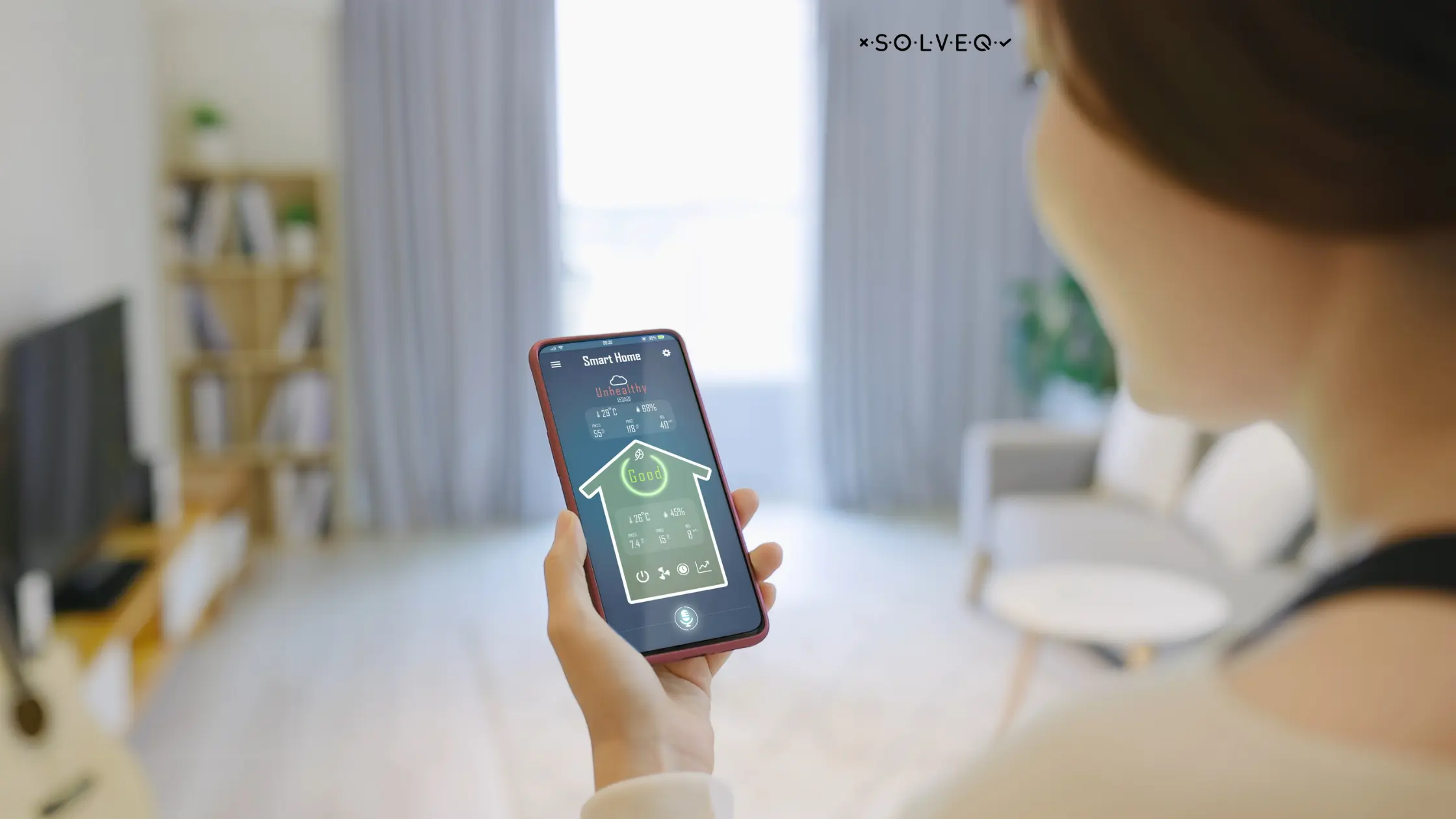
In the world of IoT, where a multitude of devices and platforms intermingle, the idea of developing software that works across different systems is more than just a tech strategy; it's essential. Think of it as the "Code Once, Deploy Everywhere" mindset. This approach is vital in the ever-growing and diverse IoT landscape. In this article, we'll explore why creating software that runs smoothly on various devices and platforms is so crucial for IoT. We'll look at how it not only makes things more efficient but also widens your reach and ensures users get a consistent experience, no matter the device or platform they use. As IoT keeps evolving, getting to grips with cross-platform development is key for anyone making their way through this exciting and ever-changing field.
The Challenges of IoT Development
The development of IoT solutions, particularly in a cross-platform context, involves navigating a complex landscape of challenges. These challenges can be categorized into three main areas: device diversity, integration complexities, and security considerations.
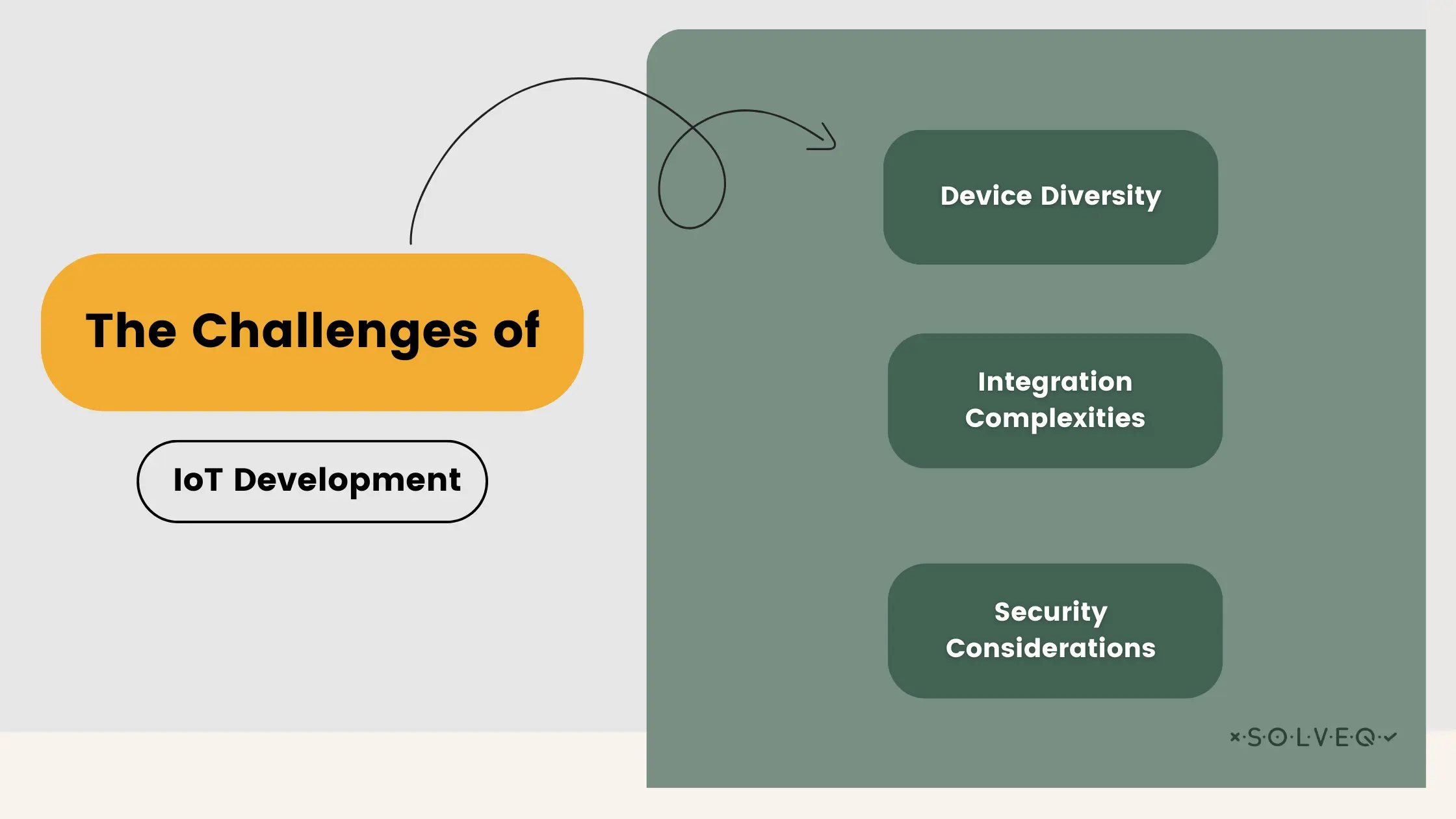
Device Diversity
The IoT ecosystem is characterized by an extensive range of devices, each differing in hardware configurations and operating systems. This diversity presents a significant challenge:
- Varied Hardware and Software: From smart home devices to industrial sensors, each IoT device has unique requirements.
- Adapting to Evolving Technology: The continuous introduction of new devices demands developers' adaptability and ongoing learning.
This aspect of IoT development requires a flexible and robust approach to support various hardware and software environments, calling for a deep understanding of diverse technological landscapes.
Integration Complexities
Integrating disparate IoT devices poses its own set of challenges:
- Communication Protocols and Data Formats: Devices in the IoT ecosystem often use different methods for data transmission, necessitating a streamlined approach for effective communication.
- Ecosystem Alignment: Ensuring that various components, including cloud services and analytics tools, work together seamlessly is crucial.
- Legacy Systems: The need to integrate with older systems adds another layer of complexity.
Developers must have a strong grasp of technical elements like network protocols and API design to manage these complexities efficiently.
Security Considerations
Developing for multiple platforms in the IoT space brings significant security challenges:
- Vulnerability Due to Interconnectivity: The interconnected nature of IoT devices increases the risk of security breaches.
- Diverse Security Architectures: Each device's unique security features necessitate a tailored approach to security.
- Continuous Security Monitoring: Developers must remain vigilant, updating and improving security measures in response to emerging threats.
A comprehensive, security-first approach is essential to protect the integrity of IoT systems across various platforms.
In summary, addressing the challenges of device diversity, integration complexities, and security considerations is crucial for successfully developing cross-platform IoT solutions. This requires not only technical expertise but also a strategic and adaptive approach, ensuring that IoT ecosystems are robust, secure, and capable of meeting the evolving needs of users.
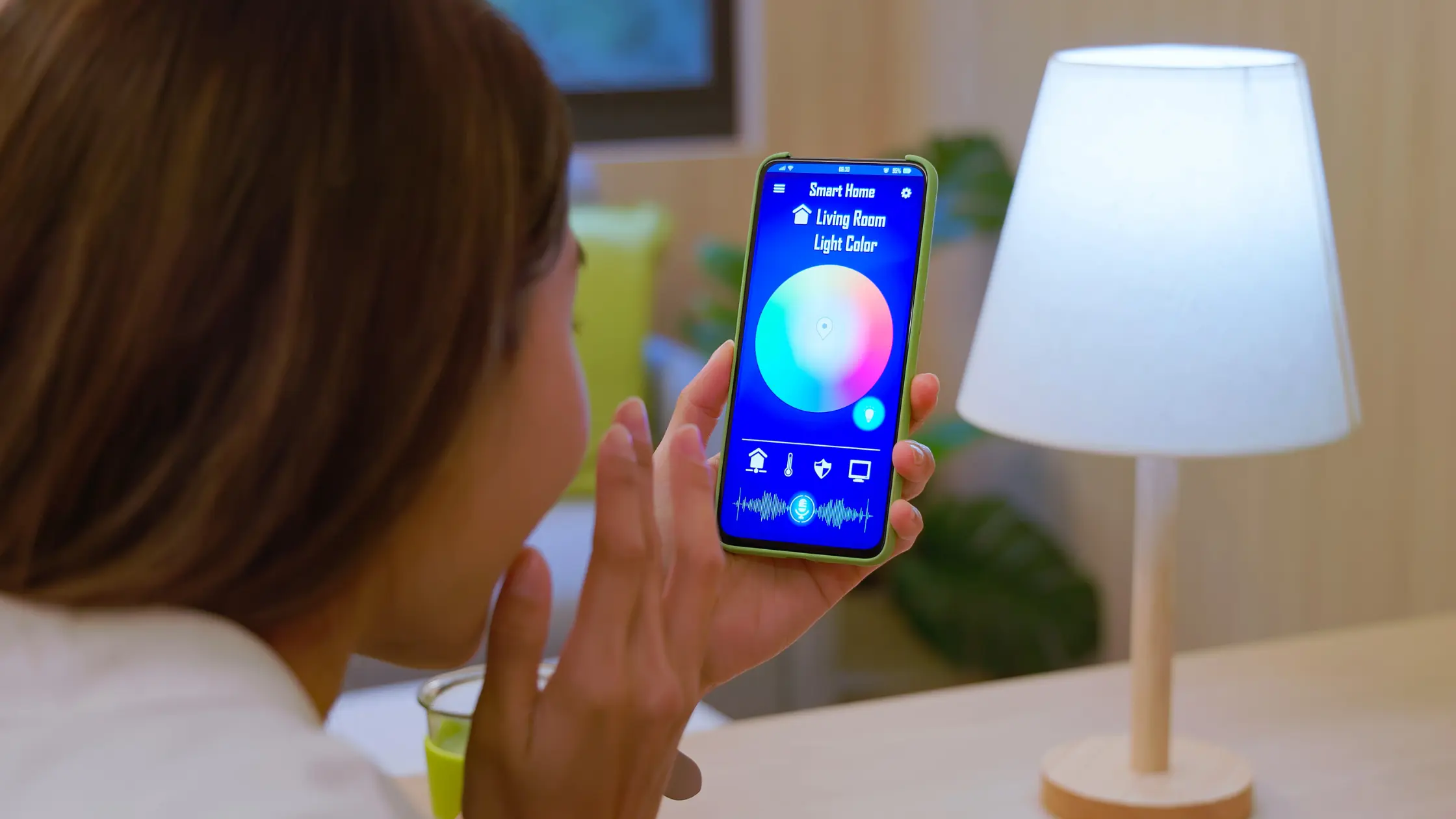
Cross-Platform Interactions in IoT Apps
In the intricate world of the Internet of Things (IoT), cross-app interactions present a blend of possibilities and challenges, particularly in terms of security and user safety. As IoT platforms become more interconnected, these interactions between various applications can inadvertently introduce significant security risks. For instance, in a smart home ecosystem, different connected devices, each controlled by separate apps, might unintentionally create security vulnerabilities due to these interactions.
To address these challenges, developers must focus on creating not only seamless connectivity but also robust security frameworks. These frameworks are crucial for safeguarding against the unpredictable nature of cross-app interactions in IoT environments. Highlighting this need are several real-world examples:
- Smart Home Systems: Devices like thermostats, security cameras, and lighting systems, when managed by different apps, can interact in ways that compromise privacy and security.
- Healthcare Monitoring Devices: Wearables and remote monitoring tools might share data across platforms, raising concerns about data integrity and patient confidentiality.
- Industrial IoT Applications: Automated machinery and sensor networks can inadvertently relay sensitive information across platforms, leading to potential security breaches.
Such examples underscore the importance of continuous innovation and adaptability in developing IoT solutions, ensuring they are not only interconnected but also secure against evolving threats.
Advantages of Cross-Platform Development Approach in IoT
Adopting a cross-platform development approach in the realm of IoT offers a multitude of benefits that cater to efficiency, scalability, and user experience. These advantages are pivotal in the current technological landscape where adaptability and reach are key.
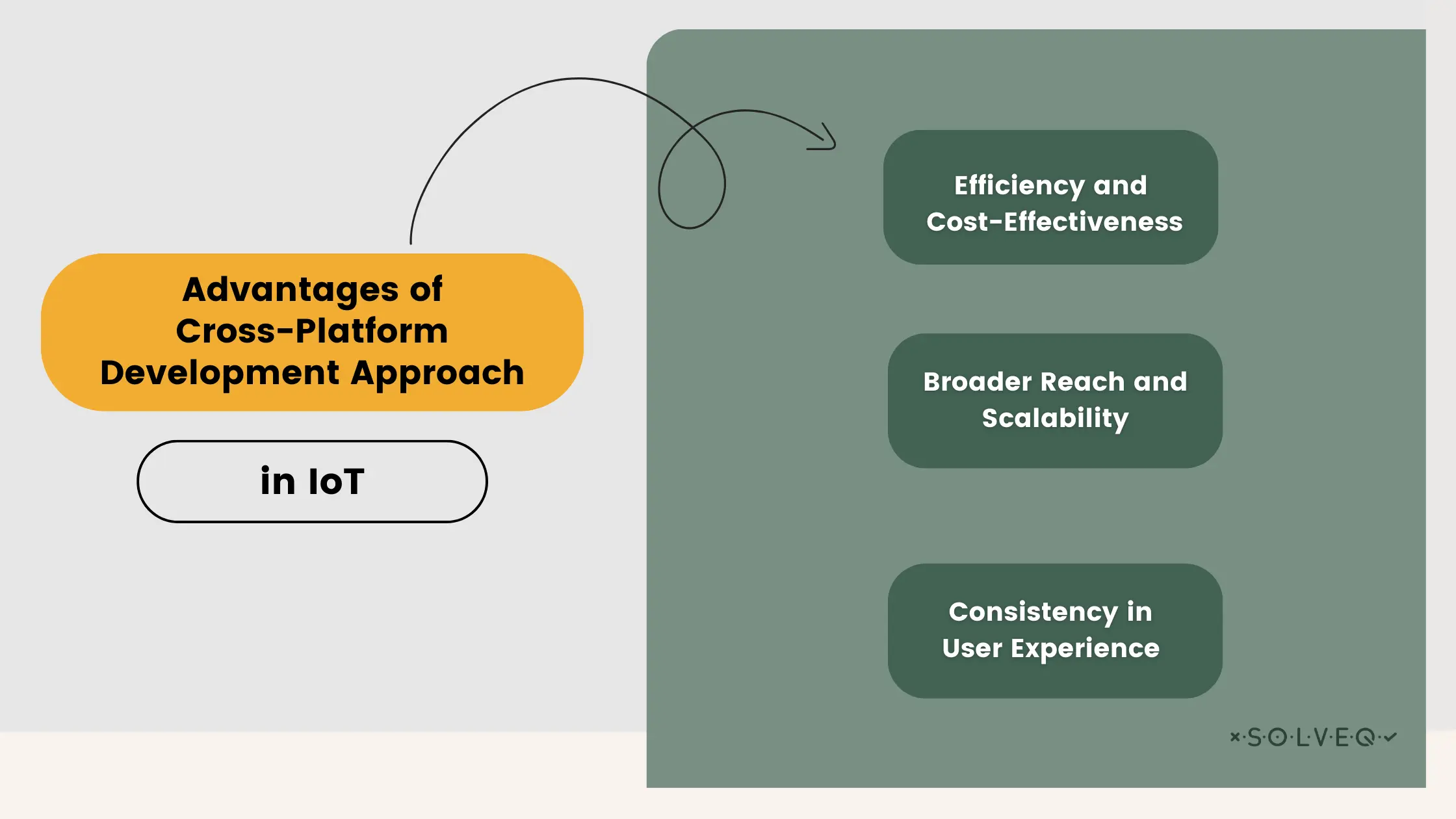
Efficiency and Cost-Effectiveness
Developing applications that are compatible across multiple platforms brings remarkable efficiency and cost benefits. By leveraging a single codebase, the need for multiple development teams working on different platform-specific versions is eliminated. This unified development approach not only streamlines the development process but also accelerates the deployment of applications. The resultant time and resource savings are substantial, reducing overall development costs and freeing up resources for innovation and improvement. Moreover, this efficiency translates into a faster time to market, a critical factor in the fast-paced IoT sector.
Broader Reach and Scalability
The cross-platform approach significantly widens the reach of IoT solutions. It allows applications to be accessible on a diverse range of devices and operating systems, catering to a broader audience. This inclusivity is especially crucial in the IoT world, where users interact with various devices, from smartphones to smart home devices.
Furthermore, scalability is a standout advantage. As the IoT ecosystem evolves and expands, solutions need to adapt and scale efficiently. Cross-platform development makes it easier to incorporate new devices and technologies into the IoT network, ensuring that applications remain relevant and functional across emerging platforms.
Consistency in User Experience
A consistent user experience across different devices and platforms is vital in retaining user engagement and satisfaction. Cross-platform development ensures that users receive the same look, feel, and functionality regardless of the device they use. This consistency is important not only for user convenience but also for brand coherence. It reduces the learning curve for new users and reinforces brand identity across various platforms.
In essence, the cross-platform development approach in IoT brings together the best of all worlds - it maximizes efficiency, broadens reach, ensures scalability, and provides a consistent user experience. These benefits make it an indispensable strategy for businesses looking to thrive in the dynamic and diverse environment of IoT.
Key Technologies and Tools
In the dynamic field of cross-platform IoT development, several frameworks and tools stand out, each offering unique capabilities and advantages. Understanding these technologies and their applications is crucial for making informed decisions about the right tools for various IoT projects.
Overview of Cross-Platform Frameworks
- Flutter: Developed by Google, Flutter is renowned for its fast development cycles, expressive and flexible UI, and native performance. Its unique approach to rendering components makes it a popular choice for creating visually appealing and highly responsive applications for both mobile and desktop platforms.
- React Native: Created by Facebook, React Native allows for the development of mobile applications using JavaScript and React. Its biggest strength lies in its vast community and rich ecosystem of libraries, making it a go-to for developers looking to leverage web development skills in mobile app development.
- Xamarin: A Microsoft-owned framework, Xamarin uses C# and .Net to build applications for Android, iOS, and Windows. Its tight integration with the Microsoft ecosystem makes it a preferred choice for projects that require extensive back-end integration and enterprise-level solutions.
Comparison and Use Cases
- Flutter: Its ability to provide a consistent UI across platforms and its superior performance in rendering complex animations and graphics makes Flutter ideal for consumer-facing applications where a rich UI/UX is paramount. Flutter's growing popularity is also supported by a strong community and a robust set of widgets.
- React Native: This framework shines in scenarios where there's a need to rapidly develop and deploy applications, especially when there's existing JavaScript and React expertise. React Native is well-suited for applications that require a native look and feel, leveraging native components while maintaining cross-platform compatibility.
- Xamarin:Xamarin excels in scenarios requiring strong integration with Microsoft products and services. It's particularly effective for enterprise applications where business logic is complex and performance requirements are stringent. Its ability to share code across platforms, coupled with native UI and performance, makes it a strong candidate for business-focused IoT solutions.
Each of these technologies offers distinct advantages and can be chosen based on the specific requirements of the IoT project, such as the target audience, performance needs, development timeline, and existing developer expertise. The right choice of technology and tools is pivotal in shaping the success of a cross-platform IoT development project.
Best Practices for Cross-Platform IoT Development
Developing for the IoT ecosystem, especially across multiple platforms, requires a strategic approach to ensure functionality, user satisfaction, and overall performance. Here are some best practices that are instrumental in achieving these goals.
Code Sharing and Modular Design
- Maximizing Code Reuse: One of the main advantages of cross-platform development is the ability to write code once and deploy it across multiple platforms. Developers should focus on creating a codebase that is as platform-agnostic as possible. This not only saves development time but also ensures consistency in logic across various platforms.
- Adopting a Modular Design: Implementing a modular design helps in breaking down the application into smaller, interchangeable components. This approach enhances maintainability, simplifies debugging, and makes it easier to update or modify parts of the application without impacting the whole system. It's particularly effective in managing large-scale projects and streamlines the process of adapting the application to different platforms.
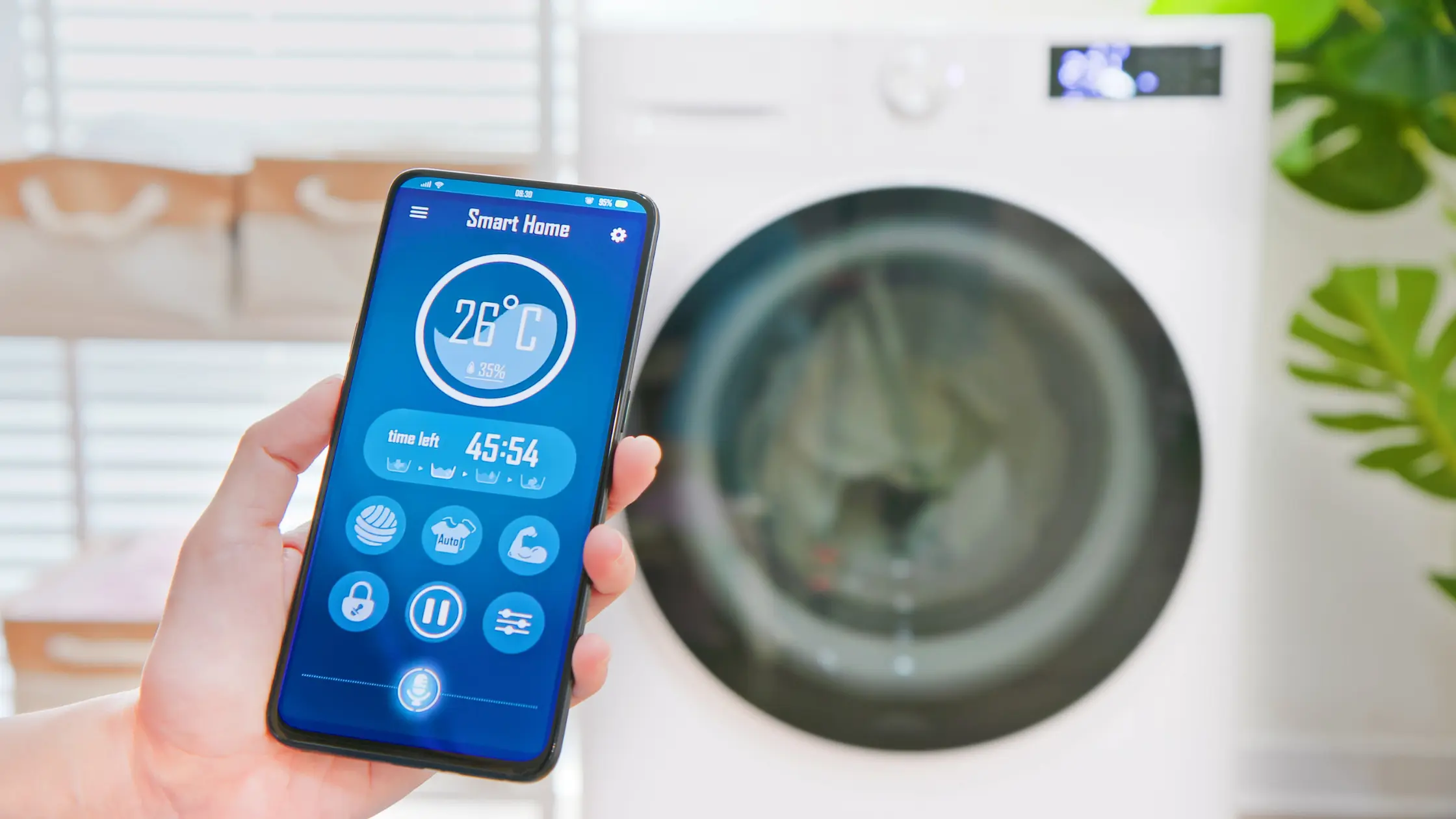
UI/UX Considerations
- Designing Flexible User Interfaces: The user interface in cross-platform development should be adaptable to different devices and screen sizes. This includes considering various aspects like layout, resolution, and input methods. Utilizing responsive design principles ensures that the application remains user-friendly and visually appealing across all devices.
- Maintaining Consistency: While adapting UIs for different platforms, maintaining a consistent look and feel is important. This consistency helps in building a coherent brand image and ensures a seamless user experience, irrespective of the platform.
- User-Centric Design: Always keep the end-user in mind. The application should be intuitive and easy to navigate, with a clear focus on the user's needs and expectations. This might involve customizing UI elements for different platforms while keeping the core design philosophy intact.
Performance Optimization
Efficient Resource Management: Efficient use of resources such as memory and processor power is crucial, especially in IoT devices with limited capacity. Developers should write optimized code and choose lightweight libraries and frameworks to ensure smooth performance.
- Testing Across Platforms: Rigorous testing across all target platforms is essential to identify and rectify performance issues. This includes load testing, which ensures that the application can handle the expected number of users and interactions without performance degradation.
- Continuous Monitoring and Updates: After deployment, continuous monitoring of the application's performance is key. Regular updates and optimizations based on user feedback and performance data help maintain and improve the application's efficiency and effectiveness.
Adhering to these best practices in cross-platform IoT development not only enhances the quality and performance of the applications but also provides a more cohesive and satisfying user experience. By focusing on code sharing, modular design, thoughtful UI/UX design, and performance optimization, developers can create robust and versatile IoT solutions that meet the diverse needs of users across various platforms.
Real-World Examples
Exploring real-world examples of cross-platform IoT development reveals insightful case studies across various industries, each demonstrating the versatility and impact of IoT technologies.
UBreez IoT App - Remote Air Quality Tracking
Developed by Indeema Software, the UBreez product is a prime example of an IoT mobile application that monitors air quality. This solution consists of three components: the UBox device, a cloud platform, and the UBreez application. Using IoT technology, it tracks indoor air quality by measuring various factors like temperature, humidity, pressure, CO2, and VOC levels. The application, available for both iOS and Android, allows users to monitor and control their surrounding air quality. This case study underscores the importance of user-friendly interfaces and the integration of cloud services for data processing and accessibility.
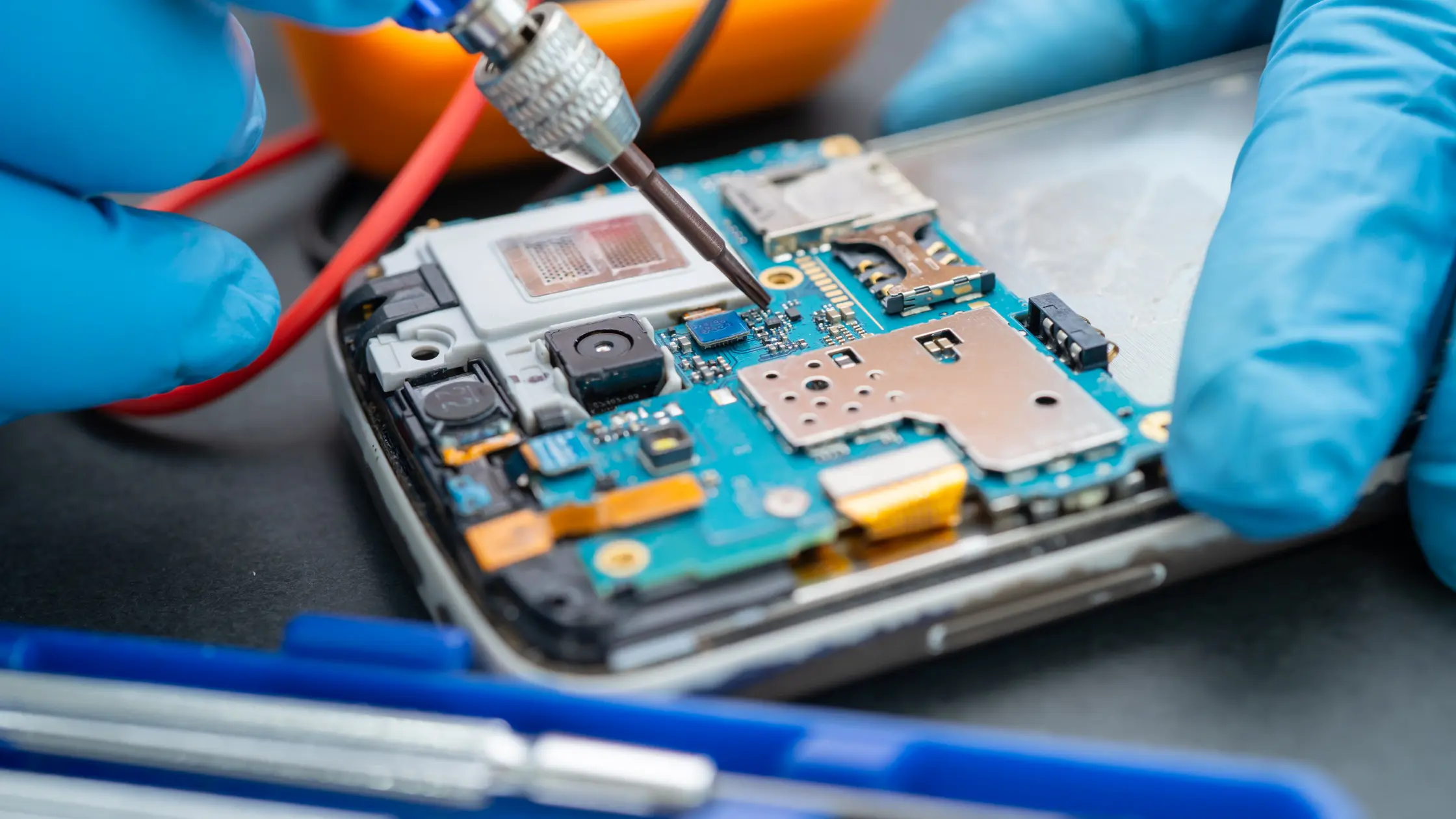
Our Case Study: Telenor
Our company also included the cross-platform solutions into one of our projects. We created a robust cross-platform mobile application developed for Telenor, Norway's largest telecommunication company. This project involved creating a unified solution for pet safety and health monitoring, specifically targeting the large and growing market of pet owners in Europe. Our development team at SolveQ faced the challenge of creating a versatile GPS tracker with cross-platform compatibility, ensuring broad accessibility regardless of the device used. Utilizing technologies like ReactNative and TypeScript, they developed a scalable backend and an interactive frontend for the application. Key features included real-time tracking, geofencing, and activity recording. The project highlighted the importance of rapid team assembly, effective project management, and cross-platform efficiency in meeting the client's needs and achieving a high satisfaction rate. For more detailed information, you can visit the case study on our website.
Industrial IoT Case Studies
IoT has revolutionized efficiency, safety, and productivity in the industrial sector. For instance:
- Tom Farms: Leveraged IoT for efficient irrigation and distribution of produce. They adopted self-driving tractors, GPS data, and sensors, alongside iPhone apps, to optimize their farming practices.
- Airbus: Used IoT to create a future-focused factory, improving production capacity and streamlining operations. They integrated sensors in tools and machines for monitoring assembly processes and introduced wearable technology for workplace safety.
- Tesla: A notable example in the automotive industry, where IoT-based applications are used for customizing cars according to customer needs. Features like autopilot mode, connectivity, and mobile application control in Tesla cars are powered by IoT.
- General Electric (GE):Utilizes IoT in its industrial machinery not just for control and monitoring but also for predictive maintenance, helping to foresee potential breakdowns.
These cases illustrate the diverse applications of IoT across industries, highlighting the significance of real-time data analytics, edge computing, and the integration of IoT with other technologies like AI and machine learning. They showcase the transformative impact of IoT in enhancing operational efficiency and paving the way for innovative approaches to industrial challenges.
Emerging Trends and Future Outlook
The landscape of cross-platform IoT development is rapidly evolving, driven by technological advancements and the increasing demand for IoT solutions. Here's an overview of the latest trends and a speculative outlook on the future of IoT development.
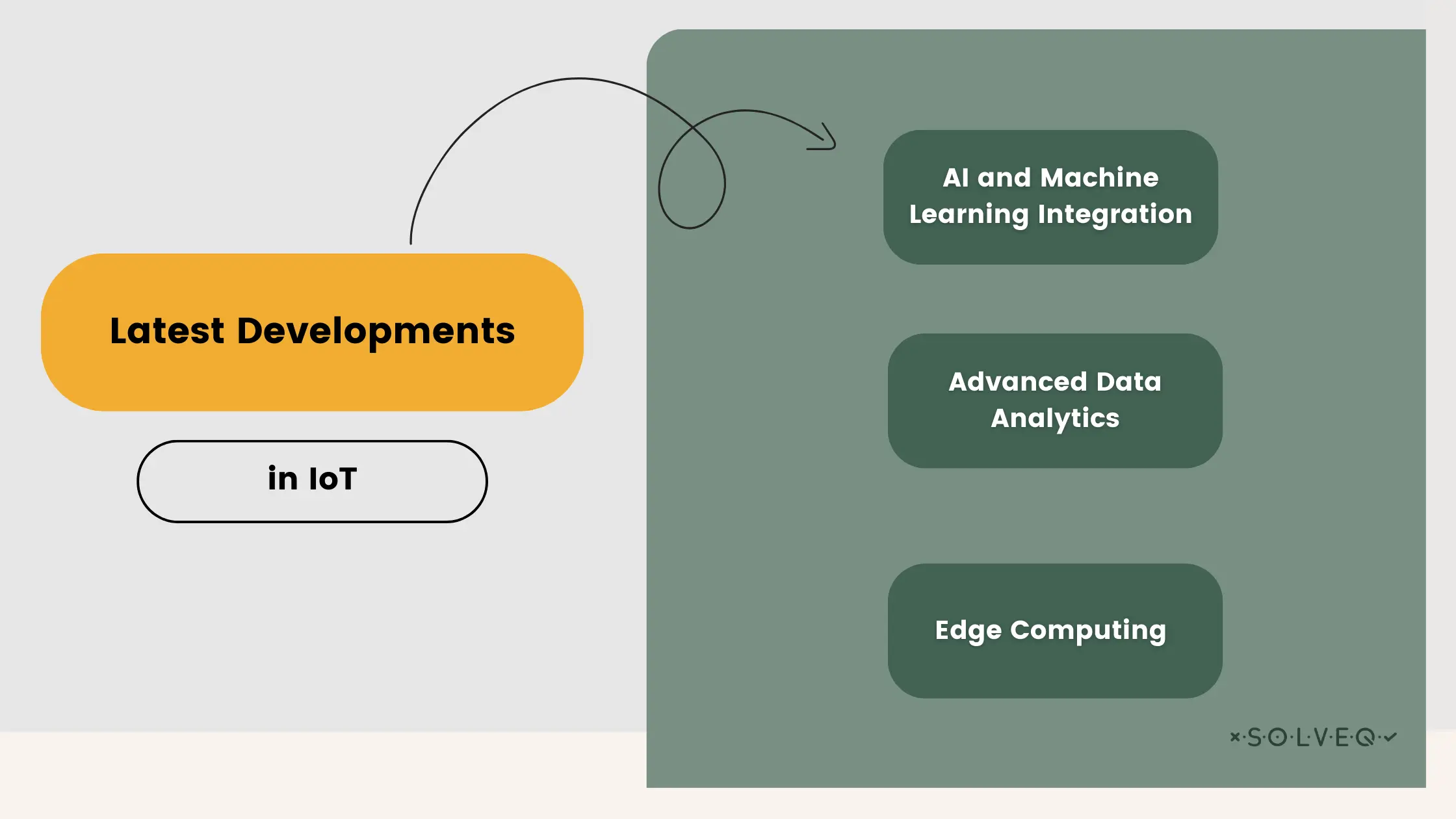
Latest Developments
- AI and Machine Learning Integration: One of the most significant trends is the integration of Artificial Intelligence (AI) and Machine Learning (ML) into cross-platform development processes. These technologies are increasingly being used to automate and optimize various aspects of development, from predictive analytics for user behavior to automated testing and deployment. AI and ML are not only making development processes more efficient but also enabling the creation of more intelligent and adaptive IoT applications.
- Advanced Data Analytics: As IoT devices generate vast amounts of data, advanced data analytics is becoming crucial. The use of big data technologies and real-time analytics is enabling more insightful and actionable understandings of data collected from IoT devices, which in turn is driving more informed decision-making in IoT applications.
- Edge Computing: The rise of edge computing is another prominent trend. By processing data closer to where it is generated (i.e., at the edge of the network), edge computing reduces latency and bandwidth use, leading to faster and more efficient IoT applications. This is particularly important for applications that require real-time processing, such as autonomous vehicles or industrial automation.
Future of IoT Development
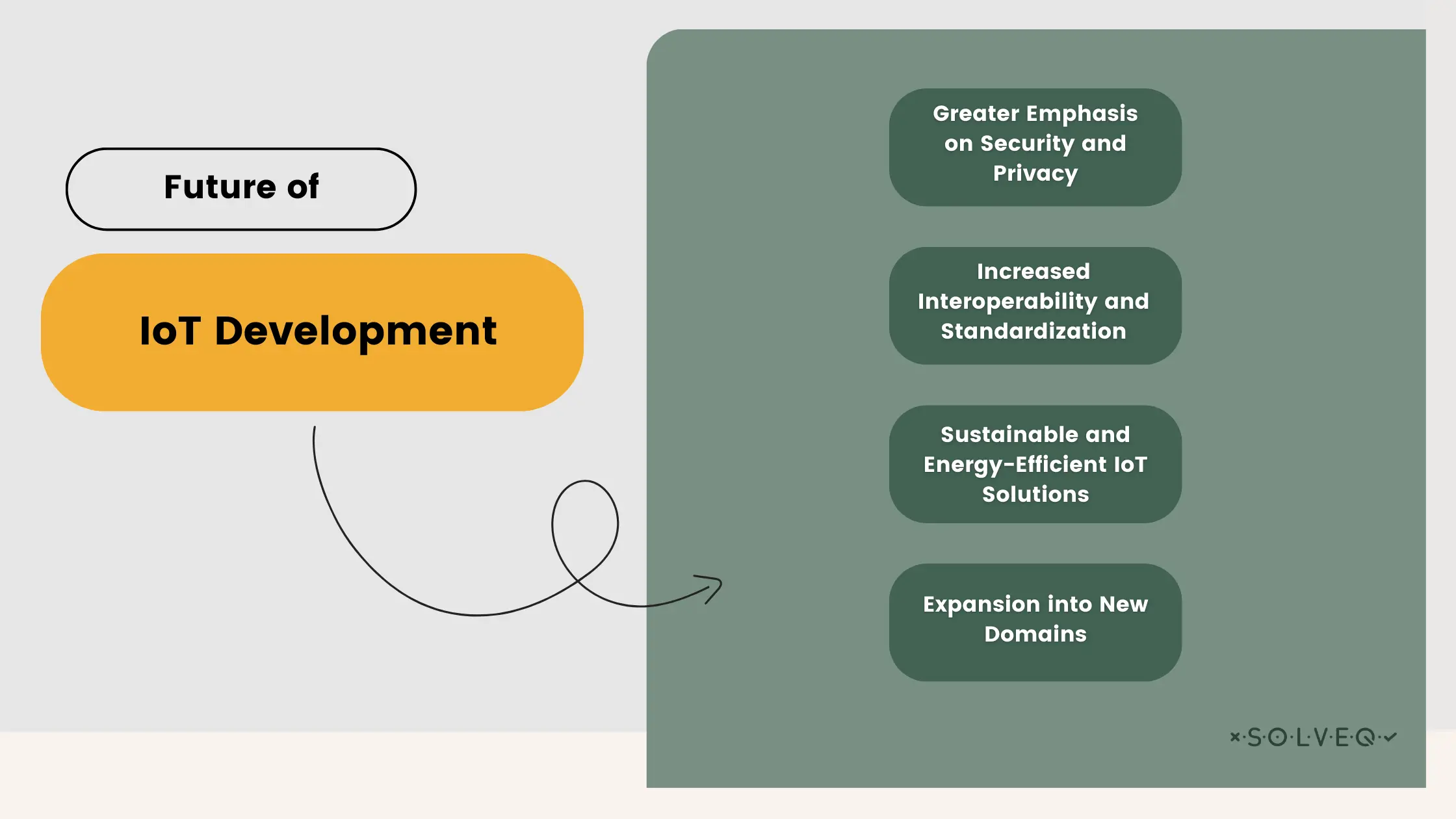
- Greater Emphasis on Security and Privacy: As IoT devices become more ubiquitous, the focus on security and privacy is expected to intensify. This will likely lead to the development of more sophisticated security protocols and privacy-preserving techniques, especially with the growing concerns around data breaches and cyber threats.
- Increased Interoperability and Standardization: As the IoT ecosystem continues to expand, there will be a greater need for interoperability and standardization across different devices and platforms. This could lead to the development of universal standards and protocols, making it easier to integrate and manage a wide range of IoT devices and systems.
- Sustainable and Energy-Efficient IoT Solutions: With the growing emphasis on sustainability, future IoT solutions are likely to focus more on energy efficiency. This could involve the development of low-power IoT devices and the use of renewable energy sources to power them.
- Expansion into New Domains: The application of IoT is expected to expand into new domains, such as smart cities, healthcare, agriculture, and more. This will open up new opportunities for cross-platform development, as solutions will need to be adaptable and scalable across different industries and use cases.
In summary, the future of IoT development is poised to be dynamic, with a focus on intelligent automation, advanced data analytics, and enhanced security and interoperability. As technologies continue to evolve, the role of cross-platform strategies in IoT development will become increasingly important, driving innovation and efficiency in this rapidly growing field.
Summary
Navigating the dynamic world of IoT, our article highlighted the essence of cross-platform development, underlining its importance in managing device diversity and ensuring security. We showcased its benefits, like cost-efficiency and broad reach, through real-world examples and discussed emerging trends like AI integration. As a specialized cross-platform and IoT software development house, we're at the forefront of these innovative changes. Join us in shaping the future of technology, leveraging our expertise to bring your IoT visions to life. Let's create something remarkable together.
Share:
Looking for expert development team?
Schedule a call with Tech Consultant

Marcin Kulawik
Founder and CEO of SolveQ. Huge fan of building things with purpose, agility, and having fun while changing the World. Loves his family, teammates, and nature.